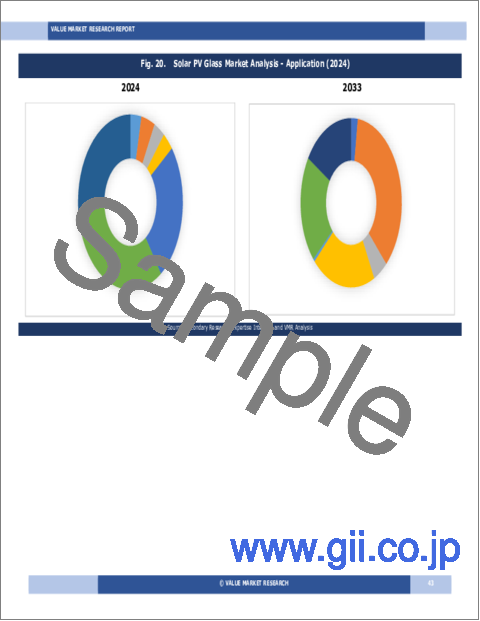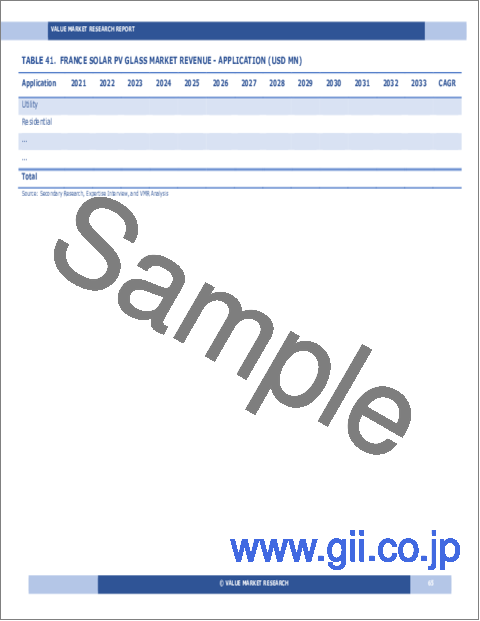|
|
市場調査レポート
商品コード
1676129
太陽光発電用ガラスの世界市場調査レポート:産業分析、規模、シェア、成長、動向、予測(2025年~2033年)Global Solar PV Glass Market Research Report- Industry Analysis, Size, Share, Growth, Trends and Forecast 2025 to 2033 |
||||||
カスタマイズ可能
|
|||||||
| 太陽光発電用ガラスの世界市場調査レポート:産業分析、規模、シェア、成長、動向、予測(2025年~2033年) |
|
出版日: 2025年03月01日
発行: Value Market Research
ページ情報: 英文 140 Pages
納期: 即日から翌営業日
|
全表示
- 概要
- 図表
- 目次
太陽光発電用ガラスの世界市場規模は、2024年の331億7,000万米ドルから2033年には3,498億4,000万米ドルに成長し、2026年から2033年の予測期間中に29.92%のCAGR(年間平均成長率)を記録すると予測されます。
太陽光発電用ガラス市場は、太陽エネルギーソリューションへの需要が高まり続ける中、大きな成長を遂げています。太陽光発電用ガラスは太陽光発電パネルの重要な部品であり、保護と耐久性を提供すると同時に、エネルギー生成のための最大限の光トランスミッションを可能にします。再生可能エネルギー導入への関心の高まりと持続可能なエネルギー源の必要性が、太陽光発電用ガラス技術への投資を促進し、市場拡大をさらに後押ししています。さらに、エネルギー効率とカーボンフットプリントの削減が重視されるようになっていることも、太陽光発電システムの採用に寄与しています。
技術の進歩は太陽光発電用ガラス市場の将来を形作る上で重要な役割を果たしています。反射防止コーティングや強化ガラス技術などのガラス製造プロセスの革新は、ソーラーパネルの性能と寿命を向上させています。さらに、透明度やエネルギー効率を調整できるスマートガラス技術の統合が、市場で人気を集めています。メーカー各社が新たなソリューションの革新と開発を続けていることから、太陽光発電用ガラス市場は、住宅、商業施設、公益事業規模の太陽光発電プロジェクトなど、さまざまな用途で採用が拡大するとみられます。
さらに、持続可能性と循環型経済原則の重視の高まりが、太陽光発電用ガラス市場の成長軌道に影響を与えています。利害関係者が廃棄物を最小限に抑え、リサイクルを促進しようとしているため、リサイクルや再利用が容易なガラス製品に対する需要が高まると予想されています。この動向は、持続可能性の目標をサポートする統合ソリューションを開発するために、ガラスメーカー、太陽電池パネルメーカー、リサイクル企業間の協力を促進しています。市場が進化し続ける中、技術、持続可能性、循環型経済の実践の統合が成功の鍵となるでしょう。
当社のレポートは、様々な産業や市場に関する包括的かつ実用的な洞察をクライアントに提供するために、細心の注意を払って作成されています。各レポートは、市場情勢を完全に理解するために、いくつかの重要な要素を含んでいます:
市場概要:市場概要:定義、分類、業界の現状など、市場に関する詳細なイントロダクション。
市場促進要因:市場成長に影響を与える主な促進要因・抑制要因・市場促進要因・課題を詳細に分析します。このセクションでは、技術の進歩、規制の変更、新たな動向などの要因を検証します。
セグメンテーション分析:製品タイプ、用途、エンドユーザー、地域などの基準に基づき、市場を明確なセグメントに内訳。この分析により、各セグメントの業績と将来性を明らかにします。
競合情勢:市場シェア、製品ポートフォリオ、戦略的イニシアティブ、財務実績など、主要市場企業の包括的評価。主要企業が採用する競合力学と主要戦略に関する考察を提供します。
市場予測:過去のデータと現在の市場状況に基づき、一定期間における市場規模と成長動向を予測します。これには、定量的分析と将来の市場軌跡を示すグラフ表示が含まれます。
地域分析:地域ごとの市場パフォーマンスを評価し、主要市場や地域動向を明らかにします。地域の市場力学とビジネスチャンスを理解するのに役立ちます。
新たな動向と機会:現在の市場動向と新たな市場動向、技術革新、潜在的な投資対象分野を特定します。将来の市場開拓と成長見通しに関する洞察を提供します。
目次
第1章 序文
第2章 エグゼクティブサマリー
- 市場のハイライト
- 世界市場スナップショット
第3章 太陽光発電用ガラス産業分析
- イントロダクション:市場力学
- 市場促進要因
- 市場抑制要因
- 機会
- 業界動向
- ポーターのファイブフォース分析
- 市場の魅力分析
第4章 バリューチェーン分析
- バリューチェーン分析
- 原材料分析
- 原材料リスト
- 原材料メーカーリスト
- 主要原材料の価格動向
- 潜在的バイヤーリスト
- マーケティングチャネル
- ダイレクトマーケティング
- インダイレクトマーケティング
- マーケティングチャネル発展動向
第5章 太陽光発電用ガラスの世界市場分析:モジュール別
- 概要:モジュール別
- 実績・予測データ分析:モジュール別
- 結晶シリコンモジュール
- アモルファス
- シリコンモジュール
- 薄膜モジュール
第6章 太陽光発電用ガラスの世界市場分析:製品タイプ別
- 概要:製品タイプ別
- 実績・予測データ分析:製品タイプ別
- 反射防止(AR)コート
- 透明導電性酸化物
- 強化ガラス
第7章 太陽光発電用ガラスの世界市場分析:用途別
- 概要:用途別
- 実績・予測データ分析: 用途別
- ユーティリティ
- 住宅用
- 非住宅用
第8章 太陽光発電用ガラスの世界市場分析:地域別
- 地域別の展望
- イントロダクション
- 北米の売上分析
- 概要、実績と予測
- 北米:セグメント別
- 北米:国別
- 米国
- カナダ
- メキシコ
- 欧州の売上分析
- 概要、実績と予測
- 欧州:セグメント別
- 欧州:国別
- 英国
- フランス
- ドイツ
- イタリア
- ロシア
- その他欧州
- アジア太平洋の売上分析
- 概要、実績と予測
- アジア太平洋:セグメント別
- アジア太平洋:国別
- 中国
- インド
- 日本
- 韓国
- オーストラリア
- 東南アジア
- その他アジア太平洋
- ラテンアメリカの売上分析
- 概要、実績と予測
- ラテンアメリカ:セグメント別
- ラテンアメリカ:国別
- ブラジル
- アルゼンチン
- ペルー
- チリ
- その他ラテンアメリカ
- 中東・アフリカの売上分析
- 概要、実績と予測
- 中東・アフリカ:セグメント別
- 中東・アフリカ:国別
- サウジアラビア
- アラブ首長国連邦
- イスラエル
- 南アフリカ
- その他中東・アフリカ
第9章 太陽光発電用ガラス企業の競合情勢
- 太陽光発電用ガラス市場の競合
- 提携・協力・合意
- 合併・買収
- 新製品発表
- その他の開発
第10章 企業プロファイル
- 上位企業の市場シェア分析
- 市場集中度
- First Solar Inc.
- Xinyi Solar Holding Ltd.
- Nippon Sheet Glass Co. Ltd.
- Yingli Green Energy Holding Company Ltd.
- Sun Power Corporation
- ReneSola Ltd.
- Hanwha Q CELLS Co.
- Saint-Gobain S.A And Guardian Industries
LIST OF TABLES
- Market Snapshot
- Drivers: Impact Analysis
- Restraints: Impact Analysis
- List of Raw Material
- List of Raw Material Manufactures
- Analysis By Module (USD MN)
- Crystalline Silicon Modules Market Sales By Geography (USD MN)
- Amorphous Market Sales By Geography (USD MN)
- Silicon Modules Market Sales By Geography (USD MN)
- Thin Film Modules Market Sales By Geography (USD MN)
- Analysis By Product Type (USD MN)
- Anti-reflective (AR) Coated Market Sales By Geography (USD MN)
- Transparent Conductive Oxide Market Sales By Geography (USD MN)
- Tempered Market Sales By Geography (USD MN)
- Analysis By Application (USD MN)
- Utility Market Sales By Geography (USD MN)
- Residential Market Sales By Geography (USD MN)
- Non-Residential Market Sales By Geography (USD MN)
- Global Solar PV Glass Market Sales By Geography (USD MN)
- North America Market Analysis (USD MN)
- United States Market Analysis (USD MN)
- Canada Market Analysis (USD MN)
- Mexico Market Analysis (USD MN)
- Europe Market Analysis (USD MN)
- Europe Market Estimate By Country (USD MN)
- United Kingdom Market Analysis (USD MN)
- France Market Analysis (USD MN)
- Germany Market Analysis (USD MN)
- Italy Market Analysis (USD MN)
- Russia Market Analysis (USD MN)
- Spain Market Analysis (USD MN)
- Rest of Europe Market Analysis (USD MN)
- Asia Pacific Market Analysis (USD MN)
- China Market Analysis (USD MN)
- Japan Market Analysis (USD MN)
- India Market Analysis (USD MN)
- South Korea Market Analysis (USD MN)
- Australia Market Analysis (USD MN)
- South East Asia Market Analysis (USD MN)
- Rest of Asia Pacific Market Analysis (USD MN)
- Latin America Market Analysis (USD MN)
- Brazil Market Analysis (USD MN)
- Argentina Market Analysis (USD MN)
- Peru Market Analysis (USD MN)
- Chile Market Analysis (USD MN)
- Rest of Latin America Market Analysis (USD MN)
- Middle East & Africa Market Analysis (USD MN)
- Saudi Arabia Market Analysis (USD MN)
- UAE Market Analysis (USD MN)
- Israel Market Analysis (USD MN)
- South Africa Market Analysis (USD MN)
- Rest of Middle East and Africa Market Analysis (USD MN)
- Partnership/Collaboration/Agreement
- Mergers And Acquisition
LIST OF FIGURES
- Research Scope of Solar PV Glass Report
- Market Research Process
- Market Research Methodology
- Global Solar PV Glass Market Size, By Region (USD MN)
- Porters Five Forces Analysis
- Market Attractiveness Analysis By Module
- Market Attractiveness Analysis By Product Type
- Market Attractiveness Analysis By Application
- Market Attractiveness Analysis By Region
- Value Chain Analysis
- Global Market Analysis By Module (USD MN)
- Crystalline Silicon Modules Market Sales By Geography (USD MN)
- Amorphous Market Sales By Geography (USD MN)
- Silicon Modules Market Sales By Geography (USD MN)
- Thin Film Modules Market Sales By Geography (USD MN)
- Global Market Analysis By Product Type (USD MN)
- Anti-reflective (AR) Coated Market Sales By Geography (USD MN)
- Transparent Conductive Oxide Market Sales By Geography (USD MN)
- Tempered Market Sales By Geography (USD MN)
- Global Market Analysis By Application (USD MN)
- Utility Market Sales By Geography (USD MN)
- Residential Market Sales By Geography (USD MN)
- Non-Residential Market Sales By Geography (USD MN)
- Global Market Sales (USD MN)
- North America Market Sales (USD MN)
- Europe Market Sales (USD MN)
- Asia Pacific Market Sales (USD MN)
- Latin America Market Sales (USD MN)
- Middle East & Africa Market Sales (USD MN)
- Recent Development in Industry
- Top Company Market Share Analysis
- Kindly note that the above listed are the basic tables and figures of the report and are not limited to the TOC.
Global Solar PV Glass Market size is anticipated to grow from USD 33.17 Billion in 2024 to USD 349.84 Billion by 2033, showcasing a robust Compound Annual Growth Rate (CAGR) of 29.92% during the forecast period of 2026 to 2033.
The Solar PV Glass Market is experiencing significant growth as the demand for solar energy solutions continues to rise. Solar PV glass is a critical component of photovoltaic panels, providing protection and durability while allowing maximum light transmission for energy generation. The increasing focus on renewable energy adoption and the need for sustainable energy sources are driving investments in solar PV glass technologies, further propelling market expansion. Additionally, the growing emphasis on energy efficiency and reducing carbon footprints is contributing to the adoption of solar PV systems.
Technological advancements are playing a crucial role in shaping the future of the solar PV glass market. Innovations in glass manufacturing processes, such as anti-reflective coatings and tempered glass technologies, are enhancing the performance and longevity of solar panels. Furthermore, the integration of smart glass technologies, which can adjust transparency and energy efficiency, is gaining traction in the market. As manufacturers continue to innovate and develop new solutions, the solar PV glass market is likely to see increased adoption across various applications, including residential, commercial, and utility-scale solar projects.
Moreover, the growing emphasis on sustainability and circular economy principles is influencing the solar PV glass market's growth trajectory. As stakeholders seek to minimize waste and promote recycling, the demand for glass products that can be easily recycled and reused is expected to rise. This trend is driving collaboration between glass manufacturers, solar panel producers, and recycling companies to develop integrated solutions that support sustainability goals. As the market continues to evolve, the integration of technology, sustainability, and circular economy practices will be key drivers of success.
Our reports are meticulously crafted to provide clients with comprehensive and actionable insights into various industries and markets. Each report encompasses several critical components to ensure a thorough understanding of the market landscape:
Market Overview: A detailed introduction to the market, including definitions, classifications, and an overview of the industry's current state.
Market Dynamics: In-depth analysis of key drivers, restraints, opportunities, and challenges influencing market growth. This section examines factors such as technological advancements, regulatory changes, and emerging trends.
Segmentation Analysis: Breakdown of the market into distinct segments based on criteria like product type, application, end-user, and geography. This analysis highlights the performance and potential of each segment.
Competitive Landscape: Comprehensive assessment of major market players, including their market share, product portfolio, strategic initiatives, and financial performance. This section provides insights into the competitive dynamics and key strategies adopted by leading companies.
Market Forecast: Projections of market size and growth trends over a specified period, based on historical data and current market conditions. This includes quantitative analyses and graphical representations to illustrate future market trajectories.
Regional Analysis: Evaluation of market performance across different geographical regions, identifying key markets and regional trends. This helps in understanding regional market dynamics and opportunities.
Emerging Trends and Opportunities: Identification of current and emerging market trends, technological innovations, and potential areas for investment. This section offers insights into future market developments and growth prospects.
SEGMENTATION COVERED IN THE REPORT
By Module
- Crystalline Silicon Modules
- Amorphous
- Silicon Modules
- Thin Film Modules
By Product Type
- Anti-reflective (AR) Coated
- Transparent Conductive Oxide
- Tempered
By Application
- Utility
- Residential
- Non-Residential
- COMPANIES PROFILED
- First Solar Inc.
- Xinyi Solar Holding Ltd.
- Nippon Sheet Glass Co. Ltd.
- Yingli Green Energy Holding Company Ltd.
- Sun Power Corporation
- ReneSola Ltd.
- Hanwha Q CELLS Co.
- Saint-Gobain S.A and Guardian Industries
- The above list can be customized.
TABLE OF CONTENTS
1. PREFACE
- 1.1. Report Description
- 1.1.1 Objective
- 1.1.2 Target Audience
- 1.1.3 Unique Selling Proposition (USP) & offerings
- 1.2. Research Scope
- 1.3. Research Methodology
- 1.3.1 Market Research Process
- 1.3.2 Market Research Methodology
2. EXECUTIVE SUMMARY
- 2.1. Highlights of Market
- 2.2. Global Market Snapshot
3. SOLAR PV GLASS INDUSTRY ANALYSIS
- 3.1. Introduction - Market Dynamics
- 3.2. Market Drivers
- 3.3. Market Restraints
- 3.4. Opportunities
- 3.5. Industry Trends
- 3.6. Porters Five Force Analysis
- 3.7. Market Attractiveness Analysis
- 3.7.1 Market Attractiveness Analysis By Module
- 3.7.2 Market Attractiveness Analysis By Product Type
- 3.7.3 Market Attractiveness Analysis By Application
- 3.7.4 Market Attractiveness Analysis By Region
4. VALUE CHAIN ANALYSIS
- 4.1. Value Chain Analysis
- 4.2. Raw Material Analysis
- 4.2.1 List of Raw Materials
- 4.2.2 Raw Material Manufactures List
- 4.2.3 Price Trend of Key Raw Materials
- 4.3. List of Potential Buyers
- 4.4. Marketing Channel
- 4.4.1 Direct Marketing
- 4.4.2 Indirect Marketing
- 4.4.3 Marketing Channel Development Trend
5. GLOBAL SOLAR PV GLASS MARKET ANALYSIS BY MODULE
- 5.1. Overview By Module
- 5.2. Historical and Forecast Data Analysis By Module
- 5.3. Crystalline Silicon Modules Historic and Forecast Sales By Regions
- 5.4. Amorphous Historic and Forecast Sales By Regions
- 5.5. Silicon Modules Historic and Forecast Sales By Regions
- 5.6. Thin Film Modules Historic and Forecast Sales By Regions
6. GLOBAL SOLAR PV GLASS MARKET ANALYSIS BY PRODUCT TYPE
- 6.1. Overview By Product Type
- 6.2. Historical and Forecast Data Analysis By Product Type
- 6.3. Anti-reflective (AR) Coated Historic and Forecast Sales By Regions
- 6.4. Transparent Conductive Oxide Historic and Forecast Sales By Regions
- 6.5. Tempered Historic and Forecast Sales By Regions
7. GLOBAL SOLAR PV GLASS MARKET ANALYSIS BY APPLICATION
- 7.1. Overview By Application
- 7.2. Historical and Forecast Data Analysis By Application
- 7.3. Utility Historic and Forecast Sales By Regions
- 7.4. Residential Historic and Forecast Sales By Regions
- 7.5. Non-Residential Historic and Forecast Sales By Regions
8. GLOBAL SOLAR PV GLASS MARKET ANALYSIS BY GEOGRAPHY
- 8.1. Regional Outlook
- 8.2. Introduction
- 8.3. North America Sales Analysis
- 8.3.1 Overview, Historic and Forecast Data Sales Analysis
- 8.3.2 North America By Segment Sales Analysis
- 8.3.3 North America By Country Sales Analysis
- 8.3.4 United States Sales Analysis
- 8.3.5 Canada Sales Analysis
- 8.3.6 Mexico Sales Analysis
- 8.4. Europe Sales Analysis
- 8.4.1 Overview, Historic and Forecast Data Sales Analysis
- 8.4.2 Europe By Segment Sales Analysis
- 8.4.3 Europe By Country Sales Analysis
- 8.4.4 United Kingdom Sales Analysis
- 8.4.5 France Sales Analysis
- 8.4.6 Germany Sales Analysis
- 8.4.7 Italy Sales Analysis
- 8.4.8 Russia Sales Analysis
- 8.4.9 Rest Of Europe Sales Analysis
- 8.5. Asia Pacific Sales Analysis
- 8.5.1 Overview, Historic and Forecast Data Sales Analysis
- 8.5.2 Asia Pacific By Segment Sales Analysis
- 8.5.3 Asia Pacific By Country Sales Analysis
- 8.5.4 China Sales Analysis
- 8.5.5 India Sales Analysis
- 8.5.6 Japan Sales Analysis
- 8.5.7 South Korea Sales Analysis
- 8.5.8 Australia Sales Analysis
- 8.5.9 South East Asia Sales Analysis
- 8.5.10 Rest Of Asia Pacific Sales Analysis
- 8.6. Latin America Sales Analysis
- 8.6.1 Overview, Historic and Forecast Data Sales Analysis
- 8.6.2 Latin America By Segment Sales Analysis
- 8.6.3 Latin America By Country Sales Analysis
- 8.6.4 Brazil Sales Analysis
- 8.6.5 Argentina Sales Analysis
- 8.6.6 Peru Sales Analysis
- 8.6.7 Chile Sales Analysis
- 8.6.8 Rest of Latin America Sales Analysis
- 8.7. Middle East & Africa Sales Analysis
- 8.7.1 Overview, Historic and Forecast Data Sales Analysis
- 8.7.2 Middle East & Africa By Segment Sales Analysis
- 8.7.3 Middle East & Africa By Country Sales Analysis
- 8.7.4 Saudi Arabia Sales Analysis
- 8.7.5 UAE Sales Analysis
- 8.7.6 Israel Sales Analysis
- 8.7.7 South Africa Sales Analysis
- 8.7.8 Rest Of Middle East And Africa Sales Analysis
9. COMPETITIVE LANDSCAPE OF THE SOLAR PV GLASS COMPANIES
- 9.1. Solar PV Glass Market Competition
- 9.2. Partnership/Collaboration/Agreement
- 9.3. Merger And Acquisitions
- 9.4. New Product Launch
- 9.5. Other Developments
10. COMPANY PROFILES OF SOLAR PV GLASS INDUSTRY
- 10.1. Top Companies Market Share Analysis
- 10.2. Market Concentration Rate
- 10.3. First Solar Inc.
- 10.3.1 Company Overview
- 10.3.2 Company Revenue
- 10.3.3 Products
- 10.3.4 Recent Developments
- 10.4. Xinyi Solar Holding Ltd.
- 10.4.1 Company Overview
- 10.4.2 Company Revenue
- 10.4.3 Products
- 10.4.4 Recent Developments
- 10.5. Nippon Sheet Glass Co. Ltd.
- 10.5.1 Company Overview
- 10.5.2 Company Revenue
- 10.5.3 Products
- 10.5.4 Recent Developments
- 10.6. Yingli Green Energy Holding Company Ltd.
- 10.6.1 Company Overview
- 10.6.2 Company Revenue
- 10.6.3 Products
- 10.6.4 Recent Developments
- 10.7. Sun Power Corporation
- 10.7.1 Company Overview
- 10.7.2 Company Revenue
- 10.7.3 Products
- 10.7.4 Recent Developments
- 10.8. ReneSola Ltd.
- 10.8.1 Company Overview
- 10.8.2 Company Revenue
- 10.8.3 Products
- 10.8.4 Recent Developments
- 10.9. Hanwha Q CELLS Co.
- 10.9.1 Company Overview
- 10.9.2 Company Revenue
- 10.9.3 Products
- 10.9.4 Recent Developments
- 10.10. Saint-Gobain S.A And Guardian Industries
- 10.10.1 Company Overview
- 10.10.2 Company Revenue
- 10.10.3 Products
- 10.10.4 Recent Developments





